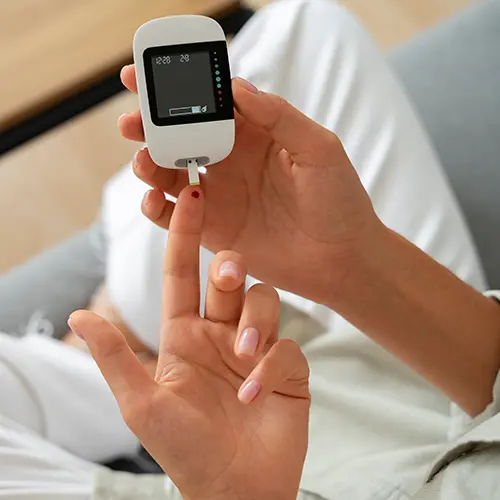Table of Contents
Diabetes, a chronic condition affecting millions worldwide, often develops quietly and without obvious symptoms. Early detection is crucial for managing and potentially mitigating its long-term effects.
This article focuses on five early signs of diabetes that shouldn't be overlooked. These signs, while sometimes subtle, can be the first indicators of changes in your body's ability to process sugar.
We discuss symptoms such as increased thirst and urination, unexplained weight loss, fatigue, blurred vision, and frequent infections.
Each of these signs is explored in detail, providing insights into why they occur and how they relate to diabetes.
The article also emphasizes the importance of not dismissing these symptoms, as early intervention can significantly impact the management and progression of diabetes.
By raising awareness and understanding of these early signs, we aim to encourage readers to seek medical advice promptly if they recognize these symptoms, thereby promoting early diagnosis and better health outcomes.
1. Frequent Urination and Excessive Thirst
Frequent urination and excessive thirst are common early symptoms of diabetes, particularly of Type 1 and Type 2 diabetes. These symptoms are part of a condition known as polyuria (frequent urination) and polydipsia (excessive thirst). Here's how they are related to diabetes:
High Blood Sugar Levels: In diabetes, the body's ability to process and use glucose (sugar) is impaired. This leads to high levels of sugar in the bloodstream. The kidneys filter this excess glucose from the blood.
Kidney Function: When blood sugar levels are too high, the kidneys try to remove the excess sugar by filtering it out of the blood and excreting it in urine. To do this, the kidneys will draw more water from the blood, which increases urine production.
Increased Urination: As a result of the kidneys working overtime to eliminate the excess glucose, a person will need to urinate more frequently. This is especially noticeable if you find yourself waking up to use the bathroom during the night (nocturia).
Dehydration and Thirst: The increased loss of fluid through urine can lead to dehydration. When you're dehydrated, your body signals you to increase fluid intake, resulting in excessive thirst. This creates a cycle of drinking more fluids, leading to even more frequent urination.
Impact on the Body: Frequent urination and excessive thirst can disrupt daily life and sleep patterns. It's important to recognize these symptoms as potential indicators of diabetes, especially if they're accompanied by other signs like unexplained weight loss, fatigue, or blurred vision.
If you're experiencing these symptoms, it's advisable to consult a healthcare professional. They can conduct blood tests to check your blood sugar levels, which can confirm whether or not you have diabetes. Early diagnosis and treatment are key in managing diabetes effectively and preventing potential complications.
2. Unexpected Weight Loss
Unexpected weight loss can be a significant early symptom of diabetes, particularly in cases of Type 1 diabetes, but it can also occur in Type 2 diabetes. This weight loss can occur even if there hasn't been a change in diet or exercise habits. Here's why it happens:
Inefficient Glucose Use: In diabetes, the body's inability to properly use glucose due to insufficient hormone production (Type 1 diabetes) or hormone resistance (Type 2 diabetes) means that cells do not receive the glucose they need for energy. Hormone is the hormone responsible for transporting glucose from the bloodstream into the cells.
Energy Shortage and Fat Burning: When the cells in the body cannot access glucose, the body starts to burn fat and muscle for energy, leading to weight loss. This process can happen even if you are eating the same amount or more than usual, because the glucose from that food is not being effectively used.
Increased Urination and Calorie Loss: As mentioned earlier, high blood sugar levels lead to frequent urination. Along with the excess sugar, your body may also be excreting calories in the urine, contributing to weight loss.
Dehydration: The process of frequent urination can lead to dehydration, which can somewhat contribute to weight loss as well.
This unexpected weight loss is often rapid and can be significant. It's particularly concerning when it occurs without a clear reason, such as a change in diet or exercise habits. If you or someone you know is experiencing unexplained weight loss along with other symptoms like frequent urination, excessive thirst, fatigue, or blurry vision, it's important to consult a healthcare professional.
A medical professional can conduct tests, such as measuring blood sugar levels, to determine if diabetes or another condition is the cause. Early detection and treatment of diabetes are crucial for managing the disease and preventing serious complications.
3. Fatigue and Weakness
Fatigue and weakness are common symptoms associated with diabetes, and they can significantly impact daily life. These symptoms are not only prevalent in those who have been diagnosed with diabetes but can also be early indicators of the condition. Here's how diabetes can lead to fatigue and weakness:
Inefficient Glucose Use: In diabetes, the body either doesn't produce enough hormone (as in Type 1 diabetes) or doesn't use hormone effectively (as in Type 2 diabetes). Hormone is the hormone that helps glucose enter cells to be used for energy. When there's a lack of hormone or resistance to it, glucose can't enter the cells efficiently, leading to an energy deficit in the body. This lack of energy can cause feelings of fatigue and weakness.
High Blood Sugar Levels: When blood sugar levels are high, it can lead to an increase in blood viscosity (thickness), making it harder for blood to circulate and deliver oxygen and nutrients to cells. This poor circulation can contribute to tiredness and a general feeling of being unwell.
Dehydration: As mentioned earlier, high blood sugar can lead to frequent urination, which may result in dehydration. Dehydration is another factor that can cause fatigue.
Stress and Mood Changes: Managing diabetes can be stressful, and stress can lead to fatigue. Moreover, fluctuations in blood sugar levels can affect mood and energy levels, contributing to feelings of tiredness and lethargy.
Sleep Disturbances: High blood sugar levels can also disrupt sleep patterns, either through the need for frequent urination during the night or through other effects such as discomfort or anxiety. Poor sleep quality can exacerbate feelings of fatigue and weakness.
If you're experiencing persistent fatigue and weakness, especially if accompanied by other symptoms like increased thirst, frequent urination, or unexplained weight loss, it's important to see a healthcare professional. They can perform tests to determine if diabetes or another condition is the cause. Managing blood sugar levels effectively through medication, diet, and exercise can significantly reduce these symptoms. Early detection and treatment of diabetes are key to preventing complications and improving overall health and energy levels.
4. Blurry Vision
Blurry vision is a common and important symptom of diabetes that should not be overlooked. It can occur in both Type 1 and Type 2 diabetes. This symptom is primarily related to the effect of high blood sugar levels on the eyes. Here's how diabetes can lead to blurry vision:
High Blood Sugar Effects: Elevated blood sugar levels can cause the lens inside the eye to swell, which changes its shape and ability to focus, leading to blurred vision.
Temporary Blurry Vision: Initially, the blurriness may be temporary and fluctuate with changing blood sugar levels. As blood sugar levels increase, vision may become more blurred, but it can improve once sugar levels are controlled.
Osmotic Changes: High levels of glucose in the blood can lead to osmotic changes, drawing more fluid into the lens of the eye and affecting its shape and clarity.
Risk of Diabetic Retinopathy: Over time, uncontrolled diabetes can damage the small blood vessels in the retina at the back of the eye, leading to a condition known as diabetic retinopathy. This condition can cause severe and potentially irreversible vision impairment if not detected and treated early.
Cataracts and Glaucoma: Diabetes also increases the risk of other eye conditions, such as cataracts (clouding of the eye's lens) and glaucoma (increased pressure in the eye), both of which can impair vision.
If you experience blurry vision, especially if it is associated with other symptoms like increased thirst, frequent urination, or unexplained weight loss, it is important to consult a healthcare professional. They can check for diabetes and other eye conditions. Managing blood sugar levels effectively is crucial to prevent or minimize the risk of diabetic eye complications.
Regular eye exams are also recommended for people with diabetes. Early detection of eye problems and timely treatment can help preserve vision. Lifestyle changes such as maintaining a healthy diet, regular exercise, and proper medication use are essential in managing diabetes and reducing the risk of complications like vision problems.
5. Tingling, Pain, or Numbness in Hands/Feet (Type 2)
Tingling, pain, or numbness in the hands and feet, often described as a "pins and needles" sensation, is a common symptom associated with Type 2 diabetes. This condition is known as diabetic neuropathy, a type of nerve damage that can occur due to high blood sugar levels. Here’s how it is related to Type 2 diabetes:
High Blood Sugar and Nerve Damage: Over time, high levels of blood sugar can damage the small blood vessels that supply nerves, particularly in the extremities like the hands and feet. This damage impairs the nerves' ability to transmit signals properly, leading to sensations of tingling, pain, or numbness.
Peripheral Neuropathy: The most common form of diabetic neuropathy is peripheral neuropathy. It typically starts in the toes and feet and can progress to the hands and arms. Early symptoms include tingling, burning, or prickling sensations, which can develop into pain and numbness.
Loss of Sensation: As the condition progresses, it can lead to a loss of sensation in the affected areas. This can be particularly dangerous as it increases the risk of injuries, infections, and ulcers in the feet and legs, as individuals may not feel cuts, blisters, or other injuries.
Poor Blood Circulation: Diabetes also affects blood circulation, which can compound the effects of neuropathy. Poor circulation can slow the healing of wounds, leading to a higher risk of complications.
Management and Prevention: Managing blood sugar levels is crucial in preventing or slowing the progression of diabetic neuropathy. This includes regular monitoring of blood sugar levels, adhering to a diabetes management plan (including diet and exercise), and taking prescribed medications.
Regular Check-Ups and Foot Care: Regular check-ups with a healthcare provider are important for people with diabetes. Special attention should be given to foot care, including daily inspection of the feet, wearing proper footwear, and avoiding injuries.
If you experience tingling, pain, or numbness in your hands or feet, it's important to consult with a healthcare professional. They can perform tests to diagnose the cause and provide guidance on effective management and treatment. Early intervention can help manage symptoms and reduce the risk of more severe complications.
FAQ
What are the early signs of diabetes?
Early signs of diabetes often include increased thirst and hunger, frequent urination, fatigue, blurred vision, and unexplained weight loss. These symptoms occur because the body is unable to use glucose effectively, leading to high blood sugar levels.
Why do people with diabetes feel excessively thirsty?
This happens because high levels of sugar in the blood can lead to dehydration. The kidneys have to work harder to filter and absorb the excess glucose. When they can't keep up, the excess glucose is excreted into the urine, dragging along fluids from your tissues, which makes you dehydrated and thirsty.
Is weight loss a sign of diabetes?
Yes, unexpected weight loss can be a sign, particularly in type 1 diabetes. When your body cannot get energy from glucose due to lack of hormone, it starts burning fat and muscle for energy, leading to weight loss.
How does diabetes lead to increased hunger?
Despite eating more, people with untreated diabetes may experience hunger. This is because the body's cells are not receiving the glucose they need for energy, due to insufficient hormone or hormone resistance, signaling the body that it needs more fuel.
Can diabetes cause skin changes?
Yes, diabetes can lead to skin changes such as darkening in certain areas, especially around the neck and armpits, which may indicate hormone resistance. Also, cuts or sores that heal slowly can be a sign.
Why do people with diabetes experience fatigue?
Fatigue in diabetes is a result of insufficient sugar moving from the bloodstream into the body's cells to be used as energy. Additionally, high blood sugar can cause inflammation that leads to fatigue.
Are blurred vision and eye problems linked to diabetes?
Blurred vision can be an early sign of diabetes due to the effect of high blood sugar levels on the blood vessels in the eyes. This can cause swelling in the lenses of the eyes, affecting your ability to focus.
How does diabetes affect urination frequency?
High blood sugar levels increase urine production as the body tries to eliminate excess sugar. This leads to more frequent urination, especially at night.
What should I do if I notice these symptoms?
If you notice any of these symptoms, it's important to consult a healthcare provider. Early diagnosis and treatment of diabetes can help manage the symptoms and reduce the risk of complications.
Can these symptoms appear in both type 1 and type 2 diabetes?
Yes, these symptoms can appear in both types of diabetes, but they are more common and may develop more quickly in type 1 diabetes. In type 2 diabetes, symptoms can be milder and develop over several years.




















